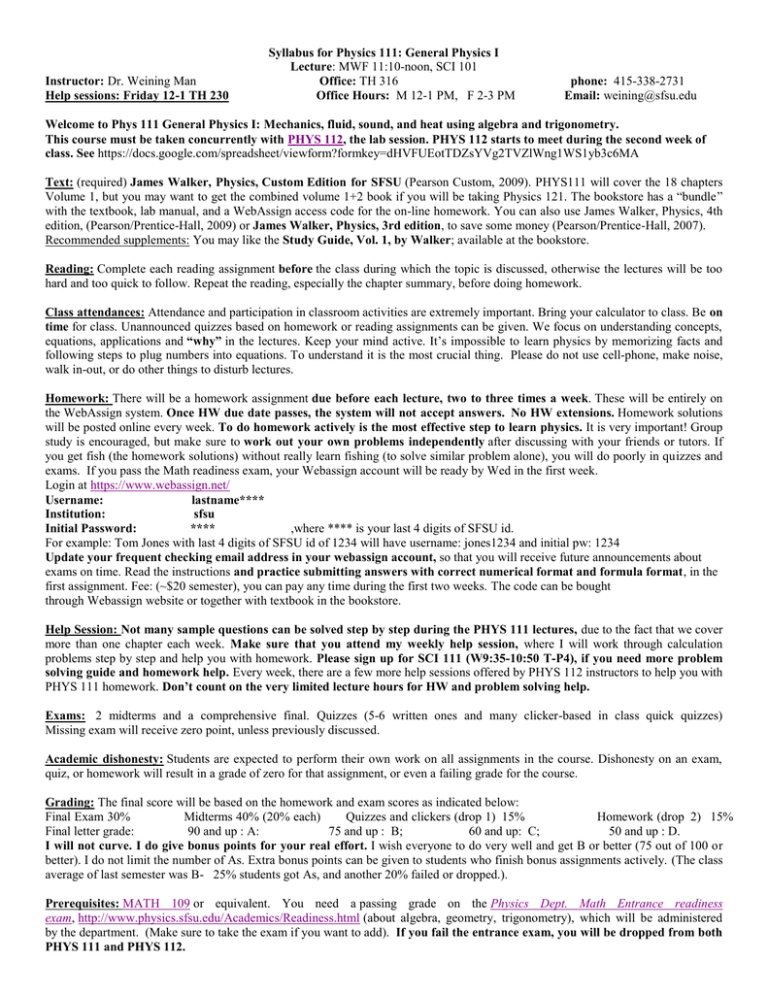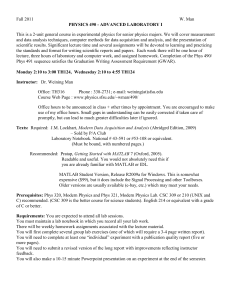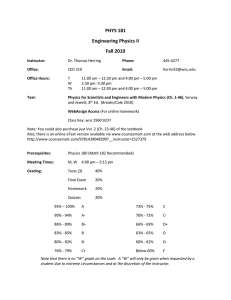
Instructor: Dr. Weining Man
Help sessions: Friday 12-1 TH 230
Syllabus for Physics 111: General Physics I
Lecture: MWF 11:10-noon, SCI 101
Office: TH 316
Office Hours: M 12-1 PM, F 2-3 PM
phone: 415-338-2731
Email: weining@sfsu.edu
Welcome to Phys 111 General Physics I: Mechanics, fluid, sound, and heat using algebra and trigonometry.
This course must be taken concurrently with PHYS 112, the lab session. PHYS 112 starts to meet during the second week of
class. See https://docs.google.com/spreadsheet/viewform?formkey=dHVFUEotTDZsYVg2TVZlWng1WS1yb3c6MA
Text: (required) James Walker, Physics, Custom Edition for SFSU (Pearson Custom, 2009). PHYS111 will cover the 18 chapters
Volume 1, but you may want to get the combined volume 1+2 book if you will be taking Physics 121. The bookstore has a “bundle”
with the textbook, lab manual, and a WebAssign access code for the on-line homework. You can also use James Walker, Physics, 4th
edition, (Pearson/Prentice-Hall, 2009) or James Walker, Physics, 3rd edition, to save some money (Pearson/Prentice-Hall, 2007).
Recommended supplements: You may like the Study Guide, Vol. 1, by Walker; available at the bookstore.
Reading: Complete each reading assignment before the class during which the topic is discussed, otherwise the lectures will be too
hard and too quick to follow. Repeat the reading, especially the chapter summary, before doing homework.
Class attendances: Attendance and participation in classroom activities are extremely important. Bring your calculator to class. Be on
time for class. Unannounced quizzes based on homework or reading assignments can be given. We focus on understanding concepts,
equations, applications and “why” in the lectures. Keep your mind active. It’s impossible to learn physics by memorizing facts and
following steps to plug numbers into equations. To understand it is the most crucial thing. Please do not use cell-phone, make noise,
walk in-out, or do other things to disturb lectures.
Homework: There will be a homework assignment due before each lecture, two to three times a week. These will be entirely on
the WebAssign system. Once HW due date passes, the system will not accept answers. No HW extensions. Homework solutions
will be posted online every week. To do homework actively is the most effective step to learn physics. It is very important! Group
study is encouraged, but make sure to work out your own problems independently after discussing with your friends or tutors. If
you get fish (the homework solutions) without really learn fishing (to solve similar problem alone), you will do poorly in quizzes and
exams. If you pass the Math readiness exam, your Webassign account will be ready by Wed in the first week.
Login at https://www.webassign.net/
Username:
lastname****
Institution:
sfsu
Initial Password:
****
,where **** is your last 4 digits of SFSU id.
For example: Tom Jones with last 4 digits of SFSU id of 1234 will have username: jones1234 and initial pw: 1234
Update your frequent checking email address in your webassign account, so that you will receive future announcements about
exams on time. Read the instructions and practice submitting answers with correct numerical format and formula format, in the
first assignment. Fee: (~$20 semester), you can pay any time during the first two weeks. The code can be bought
through Webassign website or together with textbook in the bookstore.
Help Session: Not many sample questions can be solved step by step during the PHYS 111 lectures, due to the fact that we cover
more than one chapter each week. Make sure that you attend my weekly help session, where I will work through calculation
problems step by step and help you with homework. Please sign up for SCI 111 (W9:35-10:50 T-P4), if you need more problem
solving guide and homework help. Every week, there are a few more help sessions offered by PHYS 112 instructors to help you with
PHYS 111 homework. Don’t count on the very limited lecture hours for HW and problem solving help.
Exams: 2 midterms and a comprehensive final. Quizzes (5-6 written ones and many clicker-based in class quick quizzes)
Missing exam will receive zero point, unless previously discussed.
Academic dishonesty: Students are expected to perform their own work on all assignments in the course. Dishonesty on an exam,
quiz, or homework will result in a grade of zero for that assignment, or even a failing grade for the course.
Grading: The final score will be based on the homework and exam scores as indicated below:
Final Exam 30%
Midterms 40% (20% each)
Quizzes and clickers (drop 1) 15%
Homework (drop 2) 15%
Final letter grade:
90 and up : A:
75 and up : B;
60 and up: C;
50 and up : D.
I will not curve. I do give bonus points for your real effort. I wish everyone to do very well and get B or better (75 out of 100 or
better). I do not limit the number of As. Extra bonus points can be given to students who finish bonus assignments actively. (The class
average of last semester was B- 25% students got As, and another 20% failed or dropped.).
Prerequisites: MATH 109 or equivalent. You need a passing grade on the Physics Dept. Math Entrance readiness
exam, http://www.physics.sfsu.edu/Academics/Readiness.html (about algebra, geometry, trigonometry), which will be administered
by the department. (Make sure to take the exam if you want to add). If you fail the entrance exam, you will be dropped from both
PHYS 111 and PHYS 112.
Lecture Schedule and reading assignments (tentative):
lect.
day
1
M
2
W
date
08/26
Content
chap.
sec.
Units & Dimensions, Sci. Notation
1
1-8
Position, displacement, velocity
2
1-4
F
M
3
W
4
F
5
M
6
7
8
M
9
W
10
F
11
M
12
13
14
M
other events
No class, Faculty meeting
09/02
No class, Labor day
acceleration; constant acceleration motion,
2
5-6
free fall;
2
7
Quiz 1
Vectors,
3
1,2
Last Day to Drop (02/08)
W
Vectors operations, relative motion
3
3-6
F
2D kinematics; projectile motion
4
1-5
Mass, forces, ,Newton’s laws,
5
1-4
weight, Normal forces, Tension, Spring force
5,6
5/7;6/2
free body diagram, 2D force decomposition,
5
5
Static & kinetic friction;
6
1
W
forces in equilibrium
6
3
F
Circular motion & centripetal force;
6
5
Gravity and planets
12
1-2
Work
7
1
kinetic energy, power,
7
2,4
Conservative & non-conservative force, Potential energy,
8
1-2
Conservation of mechanical energy
8
3-4
09/09
09/16
09/23
09/30
W
Midterm 1
15
F
16
M
17
W
18
F
19
M
20
W
Momentum; impulse, Momentum of a system (vector),
9
1-3
21
F
Conservation of momentum, Collisions
9
4-6
22
M
2D Collisions, Center of mass,
9
6-7
23
W
Angular motion, rotational kinematics,
10
1-3
24
F
Momentum of Inertia, Rotational kinetic energy
10
5
25
M
Torque, Angular Acceleration
11
1,2
26
W
Static equilibrium, Balance
11
3,4
27
F
Angular momentum and its conservation
11
5-7
28
M
simple harmonic motion, mass on a spring
13
1-4
29
W
13
5-8
10/07
10/14
10/21
10/28
11/04
Review
Energy, Pendulum, resonance
F
M
11/11
W
FLUIDS: density, pressure, static equilibrium
15
1-3
F
Archimedes’ principle & buoyancy,
15
4-5
32
M
Flow, Bernoulli's equation, Viscosity
15
6-9
33
W
Temperature, Specific heat,
16
1-2,5
34
F
16
3-4
11/18
heat and work, thermal expansion, heat exchange
11/25
M
W
37
F
38
M
39
W
Midterm 2. Chapters 7-12
No class, Holiday
31
36
Last Day for switching to CR/NC (10/21)
Midterm 2
30
35
Midterm 1. Chapters 1– 6.
12/02
12/09
11/25-11/29, Fall Break.
Fall break, No class
Ideal gas law, kinetic theory, deformation
17
1-3
latent heat, phase changes
17
4-6
Wave on a string, standing waves
14
1-3,8
Sound wave, intensity, Doppler effect
14
4-5
Doppler effect, interference, beats…
14
6-9
th
st
Last day to withdraw
40
F
Thermodynamics laws (0 and 1 )
18
1-4
41
M
12/16
Therm. laws (2nd and 3rd) Heat engines and refrigerators
18
5-7
W
Dec 18
Final Exam Chapter 1-18
1-18
Last day of class
Final Exam: 10:45-1:15
SCI 101
Checklist of what you should do: (12-14 hours a week is expected in order to understand 18 chapters in 16 weeks.)
·
Read the text before each lecture, otherwise lectures will definitely be too quick and too hard to follow.
·
Understand all concepts, equations and “why” in lectures. You will get lost if you just memorize facts or plug numbers.
·
Don’t miss class. To make-up takes 3 times of lecture time. Carefully review notes if you have an unavoidable absence.
·
Study in groups and help each other, but do not simply give or ask for answers.
·
Finish HW independently after discussions. Make sure that you understand everything by yourself. Mark those hard ones.
·
Request keys on Webassign. Review HW solutions posted after due date. Redo all the hard ones before quizzes and exams.
·
Go to at least one help session every week. PHYS 111 lectures are not long enough for showing many step by step examples.
·
Improve your math skills. Otherwise, you will have a hard time solving equations for physical quantities.
·
Keep up with the materials as it is covered. New sessions build on the previous. It is much harder to catch up once fall behind.
Please fill the blanks with reserved time slots for PHYS 111. (A good sample is suggested below)
Reading text before lectures: (1-2hr each, 3+ times per week)
_ Su 8-10PM_______________
_T 9-10PM____________
__Th 9-10PM___________
Review Lecture notes: (0.5-1 hr each time, 3+ times per week)
_ M 7PM _____________
_W 7 PM______________
__Sa 1PM_____________
Do HW: (1-4hrs, attempt HW 3+ times a week)
_ M 8-10PM _____________
_W 8-11PM____________
__Sa 2-6PM_____________
Review HW solutions:(0.5-2 hrs)
M 7PM _____________
_Sa 1 PM____________
_Redo hard HW questions on Sun
Attend SCI 111 or office hours
(Bring all questions and have answered right away. Do not wait till falling behind.): M 7PM _____________
How to make homework easier:
·
Start to attempt HW as early as possible. To finish before the due date, allow 2-4 days (4-8 hours total) for reviewing,
practicing, and reading new chapters. It’s impossible to finish HW the night before due date. The number of allowed attempts
on calculation problems are not limited 48 hours before due date.
·
Review the text, chapter summary, lecture notes, and problem-solving steps on notes and textbooks..
·
Understand your questions before plugging numbers into equations.
·
Start the problem by drawing a diagram. Explain your solution in words.
·
If homework looks hard, first try to solve the sample problems on the book and lecture notes without peeking.
·
Pay attention to units. Check results and order of magnitude to make sure they are reasonable. Pay attention to round off error.
·
Get help--but only after trying the problems yourself. Discussions are allowed and encouraged. But NEVER cheat! Offering
or asking homework answers completely destroy the precious learning opportunities.
Make sure that you sign up for the one unit SCI111 and attend at least one help session per week, if you need problem solving
guide and homework help. Don’t count on the very limited lecture hours for HW help and problem solving help.
* Students with medical conditions or learning disabilities who need reasonable accommodations are encouraged to contact me for
necessary arrangements. The DPRC is available to facilitate the process (dprc@sfsu.edu)
Please visit my website for updates, lecture notes, and HW solutions. http://www.physics.sfsu.edu/~wman/phy111.htm
Please keep an eye on your webassign announcements and sfsu email accounts for announcements.
Please keep in touch and let me know how you are doing and how I can help. I am looking forward to a fun and successful
semester.
Let’s start the journey to the fun Physics world. Enjoy!
(Last updated Jan-17 2012)
Course objectives and learning outcomes: You will be able to
·
Study Newton's laws of motion and learn how to apply them to simple mechanical systems.
·
Learn the physical concept of energy and how it relates to different physical systems.
·
Study the phenomena involved in gravitation, wave motion and oscillations.
·
Study the concepts and phenomena in the fields of heat, thermodynamics and thermal physics.
·
Learn how to translate realistic physical problems into the equations which describe them; solve these equations for the
variables describing the problem; and interpret the results to describe the resulting behavior of the realistic physical system.
·
Learn to carry out numerical evaluation of algebraic results rapidly and accurately, using appropriate units for physical
quantities.
·
Describe simple physical systems by graphing system variables, and interpret graphs of system variables.
·
Relate the equations of physics to intuitive concepts.
* This is one of the classes that are “impacted” (more students wish to enroll than the spaces available). Withdrawal will be permitted
only if documentation of the “serious and compelling” reasons is provided. When deciding whether to withdraw from a class, please
note that university policy allows you to take the class only one more time.
Math Readiness Exam:
The readiness exam covers the following topics: No outside aids, including calculators, are allowed.
Exponents, roots, and scientific notation - ability to add, subtract, multiply, divide, and take powers and roots of variables and
numbers expressed in scientific notation.
Algebra – Ability to solve linear and quadratic algebraic equations, including use of the quadratic formula. Ability to solve
for one variable in terms of other variables. Ability to solve a set of two simultaneous equations.
Geometry – Basic knowledge of angles, triangles, perimeters and areas of figures.
Trigonometry – Ability to use sin, cos, and tan functions and the Pythagorean Theorem.
Graphing – Knowledge and ability to work with graphs of linear and quadratic functions, including understanding slopes and
intercepts and ability to write the equation for a straight line based on knowledge of the coordinates of two points on the line.
High-School Physics – Some elementary questions at the level of high-school physics courses.
There is a very useful on-line course that you can use to prepare for the readiness test.
Go to the ALEKS web site and sign up for PHYS 111 - Fall 2013 / Math Prep for College Physics MRYVU-QQVRE
The cost is $30 for 18 weeks of access. (Purchase ALEKS Math (18 weeks))
Math exam results will be posted on course website by Monday morning.
If you fail the entrance exam, you will be dropped from both PHYS 111 and PHYS 112.



